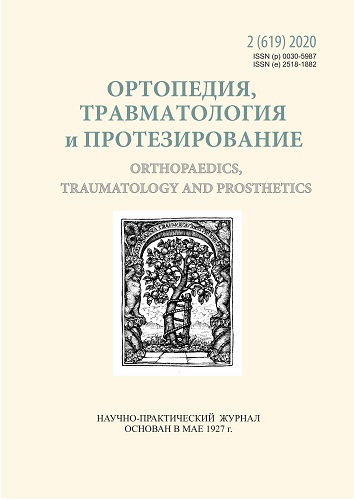Posttraumatic deformities of the bones, forming knee joint: general evaluation and treatment tactics
DOI:
https://doi.org/10.15674/0030-59872020292-98Keywords:
posttraumatic deformities, malalignments, osteotomies, lower extremities, long bones, trauma consequencesAbstract
The aim of paper: to provide modern approach to diagnostics and treatment of deformities localized around knee joint and developed after distal metadiaphysis of femur and proximal metadiaphysis of tibia fractures. It was shown, that formed deformities provoke development of secondary adaptive changes in articular surfaces of knee and its stabilizers, thigh and shin muscles. It also impairs walking. The planning of treatment should be based on proper investigation: radiologic assessment of malaligned extremity and its computer tomography, ultrasound investigation of tendons and muscles, that provide function of knee joint, assess anatomic-functional characteristics of knee joint itself (range of motion, stability, osteoarthritic changes) and malfunction of whole extremity with malaligned segment, including walking ability. Standardized technique of roentgenographic investigation and standard parameters for proper image analysis are provided. The necessity to take into consideration all changes of impaired extremity and segment, but not only the results of roentgenograms assessment, for the working-out of treatment is emphasized. The main treatment goals are: restoration of weight-bearing ability, anatomic or almost anatomic realignment to restore three-dimension orientation of articular surfaces, improvement of walking function. The main types of treatment are: different osteotomies followed with fragments fixation using extrafocal or buried osteosynthesis (intramedullary nailing or plating), restoration of ligamentous structures, arthroplasty or arthrodesis. Main indications for every variant of surgical intervention are listed.References
- McKellop, H. A., Sigholm, G., Redfern, F. C., Doyle, B., Sarmiento, A., & Luck, J. V. (1991). The effect of simulated fracture-angulations of the tibia on cartilage pressures in the knee joint. The Journal of Bone & Joint Surgery, 73(9), 1382-1391. doi: 10.2106/00004623-199173090-00014
- Hierholzer, G., & Müller, K. (2012). Corrective osteotomies of the lower extremity after trauma. Berlin-Heidelberg: Springer-Verlag, 1985. doi: 10.1007/978-3-642-70774-2
- Paley, D. (2002). Principles of deformity correction. doi: 10.1007/978-3-642-59373-4
- Probe, R. A. (2003). Lower extremity angular Malunion: Evaluation and surgical correction. Journal of the American Academy of Orthopaedic Surgeons, 11(5), 302-311. doi: 10.5435/00124635-200309000-00003
- Marti, R. K., & van Heerwaarden, R. J. (2008). Osteotomies for posttraumatic deformities. Georg Thieme Verlag
- Green, S. A., & Gibbs, P. (1994). The relationship of angulation to translation in fracture deformities. The Journal of Bone & Joint Surgery, 76(3), 390-397. doi: 10.2106/00004623-199403000-00009
- Badhe, N. P., & Forster, I. W. (2001). High tibial osteotomy in knee instability: The rationale of treatment and early results. Knee Surgery, Sports Traumatology, Arthroscopy, 10(1), 38-43. doi: 10.1007/s001670100244
- Romanenko, K. K., Doluda, Ya. A., & Zlatnik, R. V. (2018). Investigation of secondary changes in the tissues of patients with post-traumatic extra-articular deformities of the femur and tibia. Orthopedics, traumatology and prosthetics, 2, 68-77. doi: 10.15674/003059872018268-77. [in Ukrainian]
- Romanenko, K. K., Doluda, Ya. A., Karpinskyi, M. Yu., & Prozorovskyi, D. V. (2017). Features of gestational capacity of patients with post-traumatic extra-articular deformities of the femur and tibia (statographic studies).Orthopedics, traumatology and prosthetics, 2, 35-44. doi: 10.15674/0030-59872017235-44. [in Ukrainian]
- Rodriguez-Merchan, E. C. (2013). Traumatic injuries of the Knee. Springer-Verlag Mailand. doi: 10.1007/978-88-470-5298-7
- Hughes, A., Heidari, N., Mitchell, S., Livingstone, J., Jackson, M., Atkins, R., & Monsell, F. (2017). Computer hexapod-assisted orthopaedic surgery provides a predictable and safe method of femoral deformity correction. The Bone & Joint Journal, 99-B(2), 283-288. doi: 10.1302/0301-620x.99b2.bjj-2016-0271.r1
- Popsuishapka, O. K., & Khmyzov, S. O. (2003). External fixation device. Ukraine. Patent 53904 A. [in Ukrainian]
- Popsuishapka, O. K., & Khmyzov, S. O. (2002). Apparatus for external fixation of bone fragments. Ukraine. Patent 49433 А. [in Ukrainian]
Downloads
How to Cite
Issue
Section
License
Copyright (c) 2020 Konstantin Romanenko

This work is licensed under a Creative Commons Attribution 4.0 International License.
The authors retain the right of authorship of their manuscript and pass the journal the right of the first publication of this article, which automatically become available from the date of publication under the terms of Creative Commons Attribution License, which allows others to freely distribute the published manuscript with mandatory linking to authors of the original research and the first publication of this one in this journal.
Authors have the right to enter into a separate supplemental agreement on the additional non-exclusive distribution of manuscript in the form in which it was published by the journal (i.e. to put work in electronic storage of an institution or publish as a part of the book) while maintaining the reference to the first publication of the manuscript in this journal.
The editorial policy of the journal allows authors and encourages manuscript accommodation online (i.e. in storage of an institution or on the personal websites) as before submission of the manuscript to the editorial office, and during its editorial processing because it contributes to productive scientific discussion and positively affects the efficiency and dynamics of the published manuscript citation (see The Effect of Open Access).














